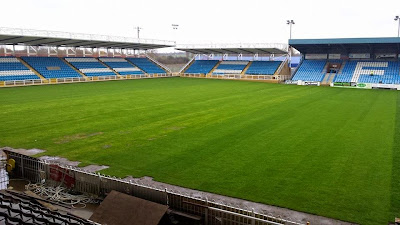Billy Stott was sold to keep the club alive
financially and Rovers had to find more local talent to fill the gaps in their
rapidly depleting team. One youngster who stepped forward was Wilf Evans, the
oldest of three brothers who started a family dynasty at Post Office Road. Wilf
was a talented back who played mainly at stand-off but also at scrum-half
during a productive eight year career spanning a total of 199 senior games with
29 tries. He formed notable halfback partnerships with Billy Hayes, Allen Ward
and Ray Hamer. Wilf’s younger brother Joe was a scrum-half who made his debut
in 1932 and went on to play 22 games over three seasons, most of them
partnering his brother in the halves. Their youngest brother was another
half-back. Ray Evans signed for Rovers in 1951 and played 73 games in four
seasons before being sold to Rochdale. Ray’s son Barry also played as a
scrum-half in the early seventies and Barry’s son Danny had a long career as a
loose-forward at Featherstone and of course is our assistant coach today.
 |
| George Johnson Junior |
Another player who featured in the thirties was the
son of Rovers’ founding father and club president. Despite his father controlling
the club, George Johnson junior had to battle his way into the team the same as
any other player. Fortunately he was good enough to dispel any hint of
favouritism. On the field Rovers had a pretty grim time of it throughout the
thirties, but Johnson did his best to lighten the gloom with some classy
touches from stand-off. He played 103 games for Rovers, managing six tries and
50 goals. Ten of those goals came on the same day against Bradford in October
1931. That record tally stood 33 years until Don Fox beat it. In January 1935
George Johnson became one of the first British players to play rugby league in
France when he was involved in a series of exhibition games playing for a
British Empire XIII. As club captain in 1935 his portrait appeared on Ogden’s
cigarette cards that year, a mark of fame in those days. Inevitably Rovers’
financial problems led him to be sold, and Hunslet came in with an offer where
Johnson linked up with former Rovers team-mates Ernie Winter and Cyril
Plenderleith.
Once Johnson had left, and Wilf Evans’ career with
Featherstone was coming to an end, Rovers used Ray Hamer at stand-off as well
as Bill Hughes and George Morgan. The latter, one of many players with that
famous surname who have played for Featherstone over the years, actually played
42 games for us at stand-off but left very little trace in the history books.
For a couple of seasons after the outbreak of the Second World War Hamer and
future head coach Harold Moxon became a relatively stable half-back combination.

No comments:
Post a Comment